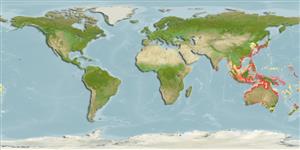Environment: milieu / climate zone / depth range / distribution range
экология
морской; солоноватоводный донно-пелагический. Tropical
Western Pacific: Taiwan Strait (Ref. 47843), eastern Australia (Ref. 7300) and Papua New Guinea (Ref. 6192).
Size / Вес / Возраст
Maturity: Lm ? range ? - ? cm
Max length : 15.0 cm TL самец/пол неопределен; (Ref. 3131)
Adults occur inshore. Omnivorous species (Ref. 7300). Eggs are guarded and fanned by the male parent (Ref. 205).
Life cycle and mating behavior
Maturities | размножение | Spawnings | Egg(s) | Fecundities | личинки
Paxton, J.R., D.F. Hoese, G.R. Allen and J.E. Hanley, 1989. Pisces. Petromyzontidae to Carangidae. Zoological Catalogue of Australia, Vol. 7. Australian Government Publishing Service, Canberra, 665 p. (Ref. 7300)
Статус Красного Списка МСОП (Ref. 130435)
Угроза для людей
Harmless
Использование человеком
дополнительная информация
инструменты
Специальные отчеты
Скачать в формате XML
ресурсы в Интернет
Estimates based on models
Preferred temperature (Ref.
123201): 22.4 - 29, mean 28.1 °C (based on 886 cells).
Phylogenetic diversity index (Ref.
82804): PD
50 = 1.0000 [Uniqueness, from 0.5 = low to 2.0 = high].
Bayesian length-weight: a=0.01288 (0.00598 - 0.02775), b=3.05 (2.86 - 3.24), in cm total length, based on LWR estimates for this (Sub)family-body shape (Ref.
93245).
Trophic level (Ref.
69278): 2.0 ±0.00 se; based on food items.
устойчивость к внешним воздействиям (Ref.
120179): высокий, минимальное время удвоения популяции до 15 месяцев (Preliminary K or Fecundity.).
Fishing Vulnerability (Ref.
59153): Low vulnerability (10 of 100).
Nutrients (Ref.
124155): Calcium = 204 [129, 416] mg/100g; Iron = 1.27 [0.78, 2.14] mg/100g; Protein = 17.3 [16.4, 18.2] %; Omega3 = 0.244 [0.126, 0.457] g/100g; Selenium = 53.3 [27.2, 109.4] μg/100g; VitaminA = 29.5 [11.0, 76.4] μg/100g; Zinc = 2.74 [1.96, 3.82] mg/100g (wet weight);
